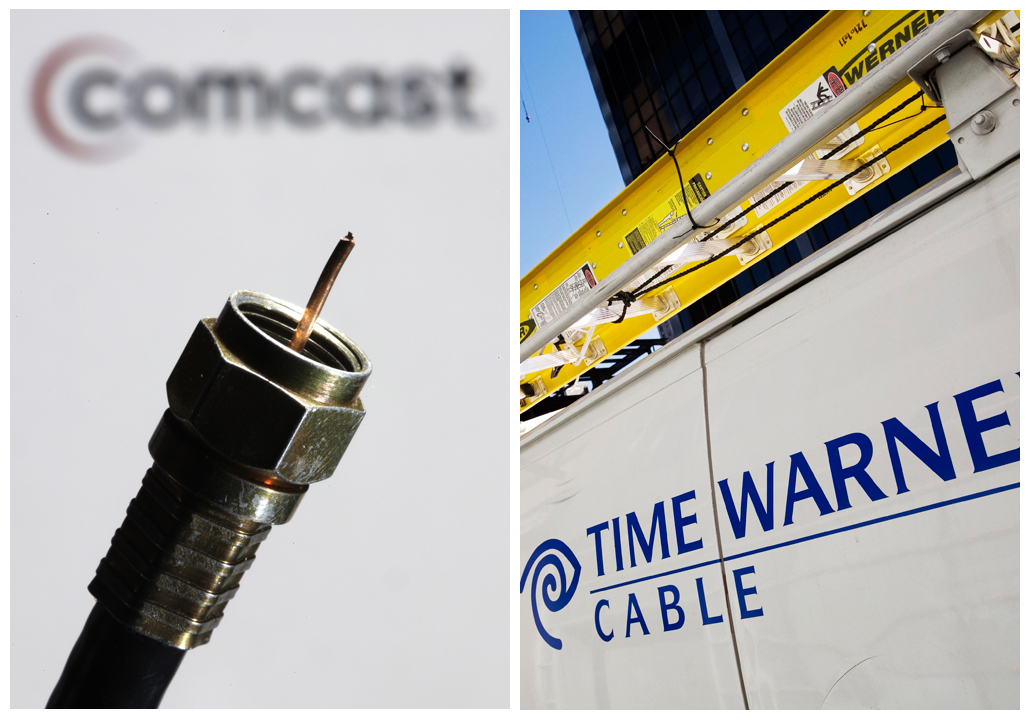 Update, April 24, 2015: This story has been updated to reflect Comcast’s official announcement that the merger has been terminated.
Update, April 24, 2015: This story has been updated to reflect Comcast’s official announcement that the merger has been terminated.
Today, Comcast announced that the company is walking away from its proposed $45.2 billion merger with Time Warner Cable. Comcast had recently met with the U.S. Department of Justice and the Federal Communications Commission. The deal had been troubled for weeks.
The Justice Department and FCC had reason to carefully evaluate the merger, which was first announced in Feb. 2014 and had been expected at the time to be completed by the end of 2014 or early 2015. If the two companies had joined, they would have controlled just under 30 percent of the country’s pay TV market and, by one measure, roughly 57 percent of the broadband Internet market (Comcast put the figure at 35 percent).
Comcast’s argument that the merger would have minimal competitive harm seems to have unraveled. Here’s some of what could have gone wrong.
TV program stifling
Comcast is already the largest video and TV service distributor in the country, according to the Leichtman Research Group. With a wider geographic footprint, it could have usedits weight to push out competition on TV airwaves, according to critics of the merger. In fact, it already has. Comcast refused to carry Univision’s sports network, Deportes Univision, one of the largest sports networks in the country and a competitor to Telemundo, which is owned by NBCUniversal and Comcast. Randy Falco, Univision’s CEO, said in an earnings call in Apr. 2014 just after the merger was proposed that he feared “this type of anticompetitive conduct would continue.” Comcast responded by saying it “has had an extraordinary, long-standing commitment to Hispanic programming,” adding through its merger with Time Warner Cable it is “committed to bringing high-quality Hispanic content to millions of additional Americans.” Just five months later, Comcast announced that it would offer Univision Deportes to its Xfinity TV subscribers in certain urban Latino markets.
John Bergmayer, senior staff attorney at Public Knowledge, expressed concerned that these practices would expand if Comcast merged with Time Warner Cable, bringing the combined company the ability to reach 33 million cable subscribers. “In a world of lots of smaller video distributors, no one of them has the ability to single-handedly dictate terms like that since a video programmer could walk away,” he wrote in an email.
Monopoly on broadband Internet service
Aside from TV, Comcast would have a number of mechanisms to squeeze out online companies. A typical household requires at least 25 mbps of Internet speed to go about their daily online routines. That might include watching an HD video over Netflix while also posting pictures to Instagram as another person in the home works on their laptop. Comcast and Time Warner Cable are two of the country’s major providers of broadband service of this speed. If they were to merge, there would be few other Internet service providers that could compete, leaving many content companies like Google’s YouTube with only one option to reach their subscribers, according to FCC filings by opponents of the merger. In this scenario, a merged Comcast/Time Warner Cable behemoth could leverage its interconnection points, which is where services like YouTube connect to stream video to their customers. Comcast could keep YouTube from offering services over its network, degrade their traffic or charge them a high fee to connect to Comcast customers. DISH Network wrote to the FCC that such chokeholds “over the broadband pipe would stifle future video competition and innovation, all to the detriment of consumers,” adding that the merger would consolidate “too much power in the hands of too few.” Comcast argued that it would “bring significant benefits to Time Warner Cable customers, including higher Internet speeds and greater reliability.”
More broken promises
Comcast agreed to conditions to facilitate past mergers, but its record of complying with them raised concerns among critics. The FCC slapped several conditions onto its approval of Comcast’s 2011 merger with NBCUniversal. For one thing, the agency required Comcast to “visibly offer and actively market standalone retail broadband Internet access service.” But just a year later an FCC investigation found that the company was not visibly marketing the standalone service and required it to pay a $800,000 fine and extend the service offer for another year. Comcast also defied what are called “neighboring” conditions. Bloomberg complained to the FCC that Comcast placed Bloomberg TV in the outer dial away from most other business networks and its own channel, CNBC, in the lower dial with other business news where viewers would be more likely to come upon it. Comcast argued that the condition only applied to future news neighborhoods, not channels that existed prior to its merger. The FCC ruled against Comcast and ordered it to place Bloomberg TV in its neighborhood lineup of business news. Even then, Comcast said this was “not a compliance issue, it’s an interpretive issue.” Comcast also violated its own voluntary agreement to respect the FCC’s 2010 net neutrality rules. In February 2014, Comcast was found slowing Netflix traffic over its network which pressured Netflix into a paid agreement to ensure its traffic reached its customers at a normal speed. David Cohen, Comcast’s executive vice president, said at a telecommunications summit three months later that paid prioritization for traffic was completely legal. “Whatever it is,” he said. “We are allowed to do it.”


